Battery System Modeling for a Military Electric Propulsion Vehicle with a Fault Simulation
Abstract
:1. Introduction

2. System Outline
2.1. Configuration of the Battery System
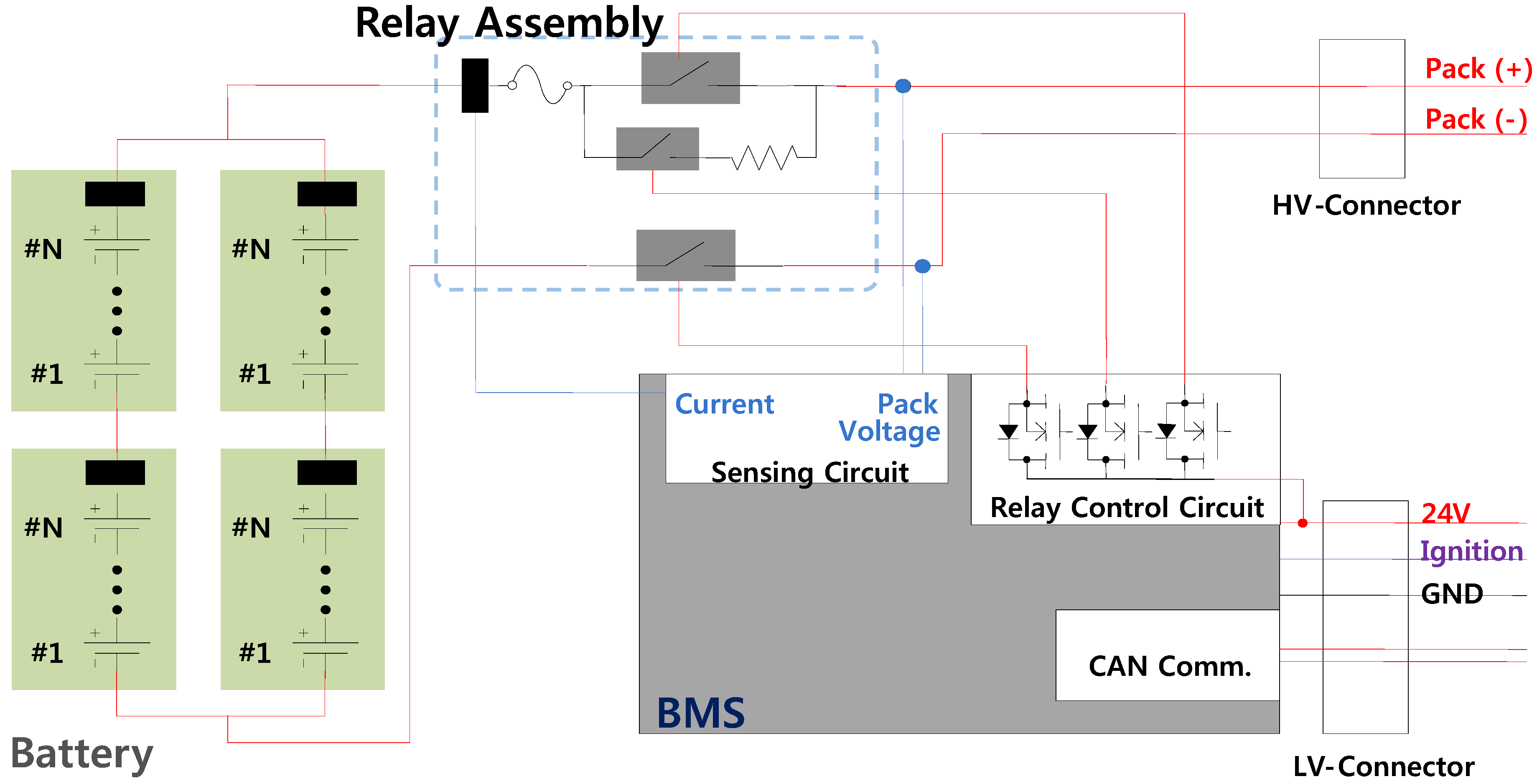
2.2. Modeling Requirement
| Fault | Detect condition | Release condition | BMS behavior |
|---|---|---|---|
| Under voltage warning | V < 550 V | Returns normal condition | Only alarm |
| Under voltage fault | V < 530 V | No release | Alarm, Relay open |
| Over voltage warning | V > 750 V | Returns normal condition | Only alarm |
| Over voltage fault | V > 770 V | No release | Alarm, Relay open |
3. Battery System Modeling
3.1. Battery Sub-Model

| Parameter | Value | Parameter | Value |
|---|---|---|---|
| (H) | 5.28×10−9 | (Ohm) | Figure 4 |
| (F) | 0.6 | (F) | 0.1 |
| (Ohm) | 1.67×10−3 | (Ohm) | 0.001 |
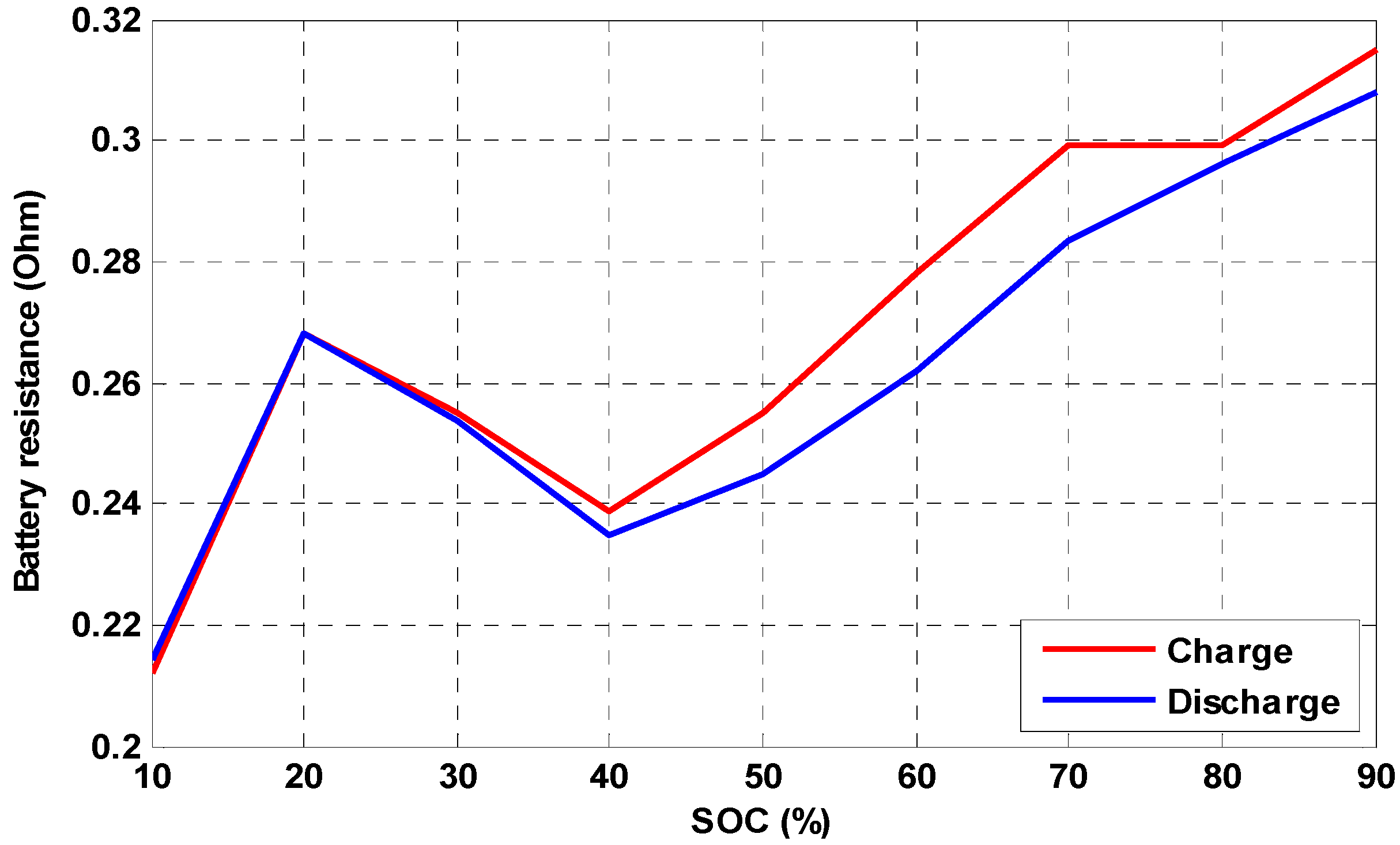
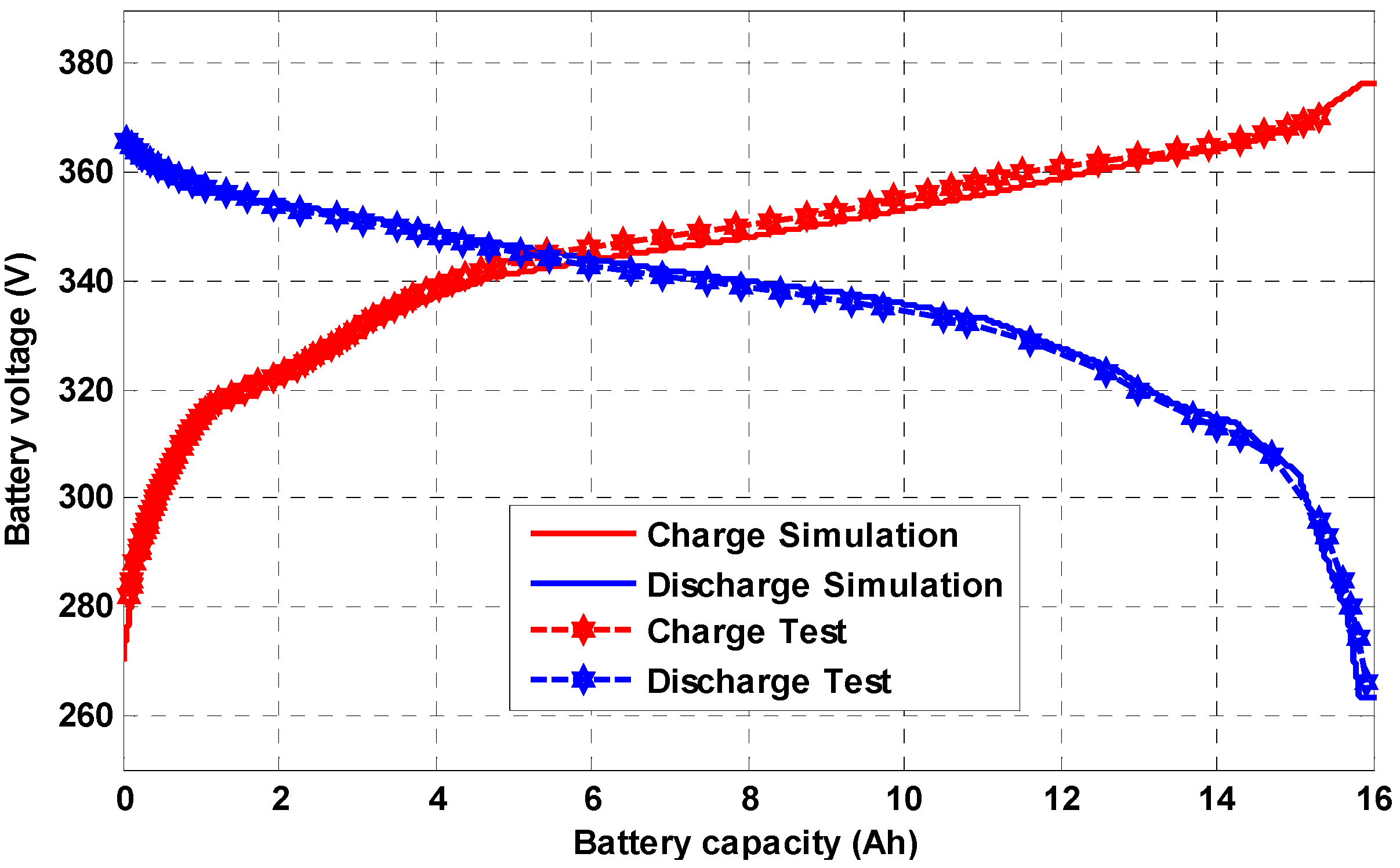
3.2. Relay Assembly Sub-Model
- Open circuit model at the relay opening;
- Pre-charging circuit model at the relay closing;
- Short circuit model at the relay close.


3.3. BMS Algorithm Sub-Model

4. Performance Evaluation

| Component | Parameter | Value | Component | Parameter | Value |
|---|---|---|---|---|---|
| Vehicle | Mass | 5500 kg | Motor 1 | Peak power | 120 kW |
| Engine | Type | Diesel | Rated power | 75 kW | |
| Rated power | 171 kW | Motor 2 | Peak power | 120 kW | |
| Battery | Type | Li-ion Polymer | Rated power | 75 kW | |
| Rated voltage | 680 V | Generator | Peak power | 120 kW | |
| Rated capacity | 31 Ah | Rated power | 85 kW |
4.1. System Characteristics Evaluation
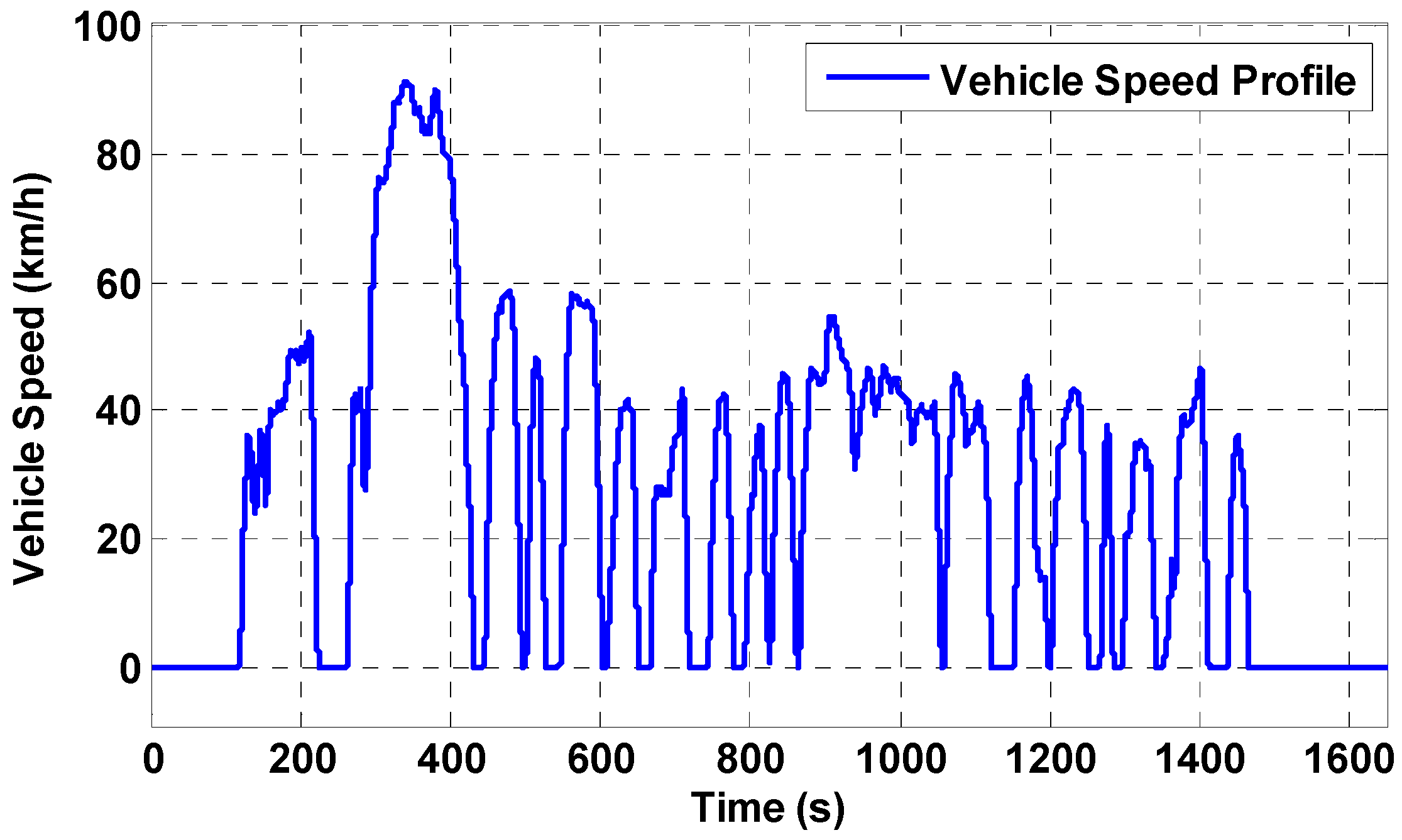

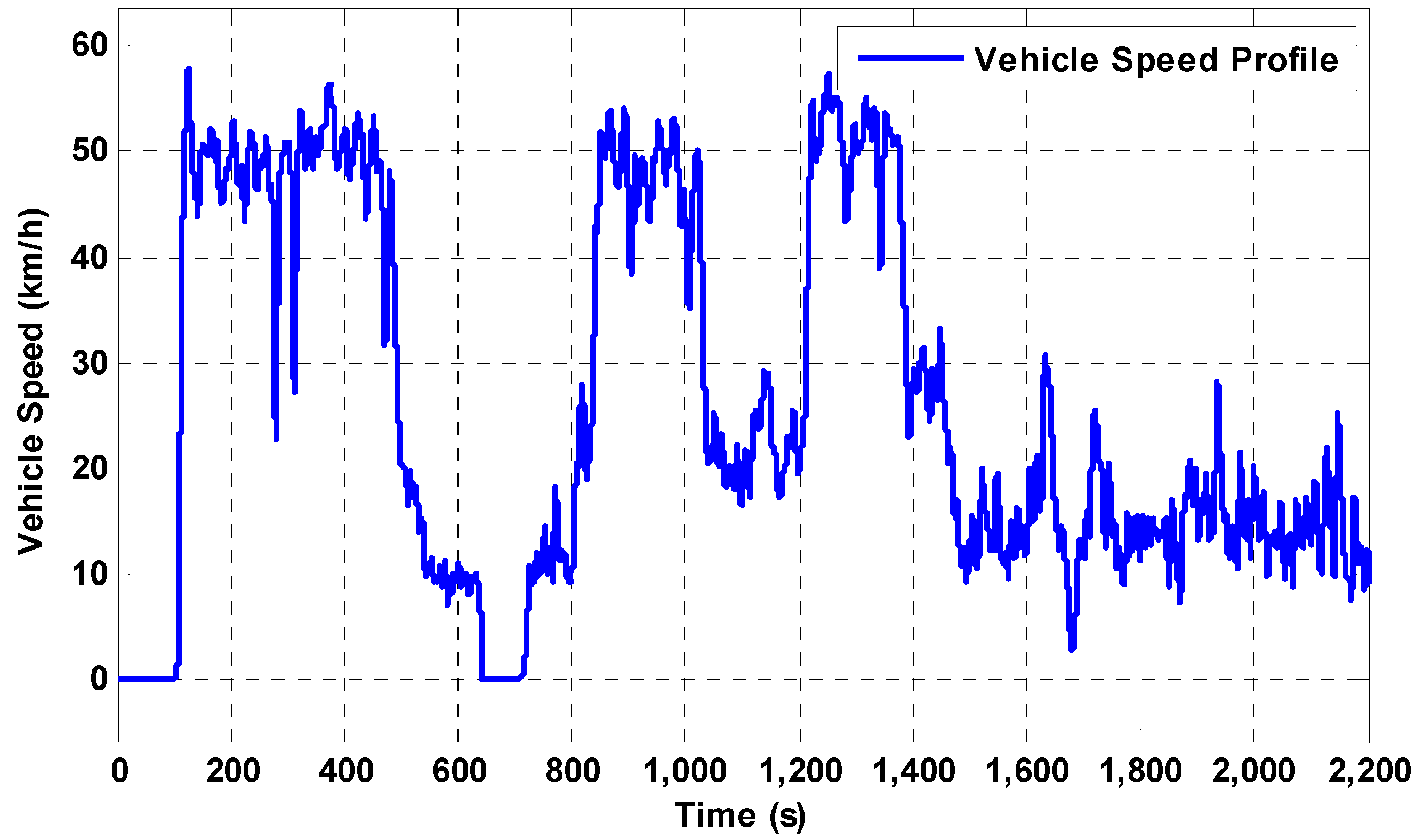

4.2. Fault Simulation
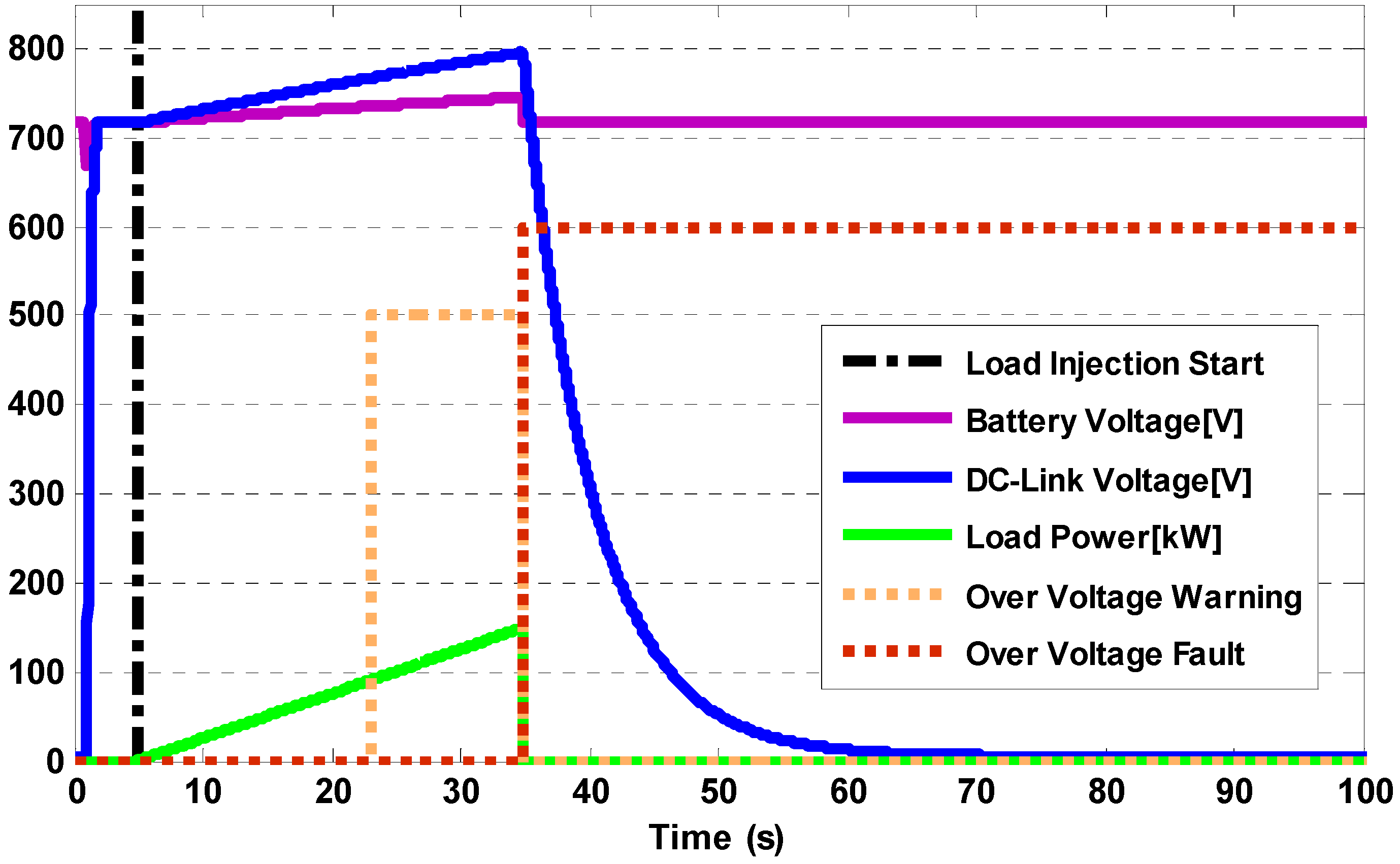
5. Conclusions
- A detailed battery system model based on the specification and the configuration of the battery system for the electric propulsion systems with real-time properties has been implemented. Some parts in the model related to the specification of the system such as the capacity of the relay assembly element and the battery capacity have been treated with parameters so the developer can easily change the battery system specification.
- Part of the battery system model is a fault simulation model to force the physical values freely. Furthermore, it has been configured to be able to accept an own fault diagnosis of the BMS to behave as the actual BMS. The results confirmed that the fault simulation of the battery system affects the other components in the configuration of the electric propulsion system. The purpose of this design is to reflect the design of the control strategy in the supervisory controller.
- As future work, the proposed battery system model connecting other component models of an electric propulsion vehicle system will be designed to validate not only the control strategy of the overall system, but also the effect of a fault in the sub-system on the entire system. This performance evaluation environment shows promise as a fast and safe development process.
Acknowledgments
Conflicts of Interest
References
- Campbell, C.J.; Laherrere, J.H. The end of cheap oil. Sci. Am. 1998, 273, 78–83. [Google Scholar] [CrossRef]
- Pisu, P.; Serrao, L.; Cantemir, C.G.; Rizzoni, G. Hybrid-Electric Powertrain Design Evaluation for Future Tactical Truck Vehicle Systems. In Proceeding of the ASME International Mechanical Engineering Congress and Exposition, Chicago, IL, USA, 5–10 November 2006; pp. 271–278.
- Hashimoto, T.; Yamaguchi, K.; Matsubara, T.; Yaguchi, H.; Takaoka, T. Development of new hybrid system for compact class vehicles. Trans. Soc. Automot. Eng. Jpn. 2010, 41, 43–47. [Google Scholar]
- Linden, D.; Reddy, T. Handbook of Batteries, 3rd ed.; McGraw-Hill: New York, NY, USA, 2001. [Google Scholar]
- Doyle, M.; Fuller, T.F.; Newman, J. Modeling of galvanostatic charge and discharge of the lithium/polymer/insertion cell. J. Electrochem. Soc. 1993, 140, 1526–1533. [Google Scholar] [CrossRef]
- Gu, W.B.; Wang, C.Y. Thermal-electrochemical modeling of battery systems. J. Electrochem. Soc. 2000, 147, 2910–2922. [Google Scholar] [CrossRef]
- Kawamura, A.; Yanagihara, T. State of Charge Estimation of Sealed Lead-Acid Batteries Used for Electric Vehicles. In Proceedings of the 29th Annual IEEE Power Electronics Specialists Conference, Fukuoka, Japan, 17–22 May 1998; pp. 583–587.
- Bhatikar, S.R.; Mahajan, R.L.; Wipke, K.; Johnson, V. Neural Network Based Battery Modeling for Hybrid Electric Vehicles. In Proceedings of the 2000 Future Car Congress, Arlington, VA, USA, 2–6 April 2000. Paper No. 2000-01-1564.
- Chan, H.L.; Sutanto, D. A New Battery Model for Use with Battery Energy Storage Systems and Electric Vehicle Power Systems. In Proceedings of the 2000 IEEE Power Engineering Society Winter Meeting, Singapore, 23–27 January 2000; pp. 470–475.
- Johnson, V.H.; Pesaran, A.A.; Sack, T. Temperature-Dependent Battery Models for High-Power Lithium-Ion Batteries. In Proceedings of the 17th Electric Vehicle Symposium, Montreal, Canada, 15–18 October 2000.
- Xie, H.; Ding, Y.B. The Study of Plug-in Hybrid Electric Vehicle Power Management Strategy Simulation. In Proceedings of the 2008 IEEE Vehicle Power and Propulsion Conference (VPPC), Harbin, China, 3–5 September 2008; pp. 1–3.
- Xu, C.H.; Niu, J.G.; Pei, F.L. Design and Simulation of the Power-Train System for an Electric Vehicle. In Proceedings of the 2011 2nd International Conference on Artificial Intelligence, Management Science and Electronic Commerce (AIMSEC), Zhengzhou, China, 8–10 August 2011; pp. 3868–3871.
- Johnson, V.H. Battery performance models in ADVISOR. J. Power Sources 2002, 110, 321–329. [Google Scholar] [CrossRef]
- Aziz, A.; Shafqat, M.S.; Qureshi, M.A.; Ahmad, I. Performance Analysis of Power Split Hybrid Electric Vehicles Using Autonomie. In Proceedings of the 2011 IEEE Student Conference on Research and Development, Cyberjaya, Malaysia, 19–20 December 2011; pp. 144–147.
- Zhang, P.Z.; Yin, C.L.; Zhang, J.W.; Chen, L. Integral power management strategy for a complex hybrid electric vehicle—Catering for the failure of an individual component. Proc. Inst. Mech. Eng. D J. Automob. Eng. 2008, 222, 719–727. [Google Scholar] [CrossRef]
- Ehsani, M.; Gao, Y.; Emadi, A. Modern Electric, Hybrid Electric, and Fuel Cell Vehicles: Fundamentals, Theory, and Design, 2nd ed.; CRC Press: Boca Raton, FL, USA, 2009. [Google Scholar]
- Jang, J.H.; Yoo, J.Y. Impedance-based and circuit-parameter-based battery models for HEV power systems. Int. J. Automot. Technol. 2008, 9, 615–623. [Google Scholar] [CrossRef]
- Kim, T. A Hybrid Battery Model Capable of Capturing Dynamic Circuit Characteristics and Nonlinear Capacity Effects. Master’s Thesis, University of Nebraska, Lincoln, NE, USA, July 2012. [Google Scholar]
© 2013 by the authors; licensee MDPI, Basel, Switzerland. This article is an open access article distributed under the terms and conditions of the Creative Commons Attribution license (http://creativecommons.org/licenses/by/3.0/).
Share and Cite
Ham, H.; Han, K.; Lee, H. Battery System Modeling for a Military Electric Propulsion Vehicle with a Fault Simulation. Energies 2013, 6, 5168-5181. https://doi.org/10.3390/en6105168
Ham H, Han K, Lee H. Battery System Modeling for a Military Electric Propulsion Vehicle with a Fault Simulation. Energies. 2013; 6(10):5168-5181. https://doi.org/10.3390/en6105168
Chicago/Turabian StyleHam, Hyeongjin, Kyuhong Han, and Hyeongcheol Lee. 2013. "Battery System Modeling for a Military Electric Propulsion Vehicle with a Fault Simulation" Energies 6, no. 10: 5168-5181. https://doi.org/10.3390/en6105168
APA StyleHam, H., Han, K., & Lee, H. (2013). Battery System Modeling for a Military Electric Propulsion Vehicle with a Fault Simulation. Energies, 6(10), 5168-5181. https://doi.org/10.3390/en6105168




